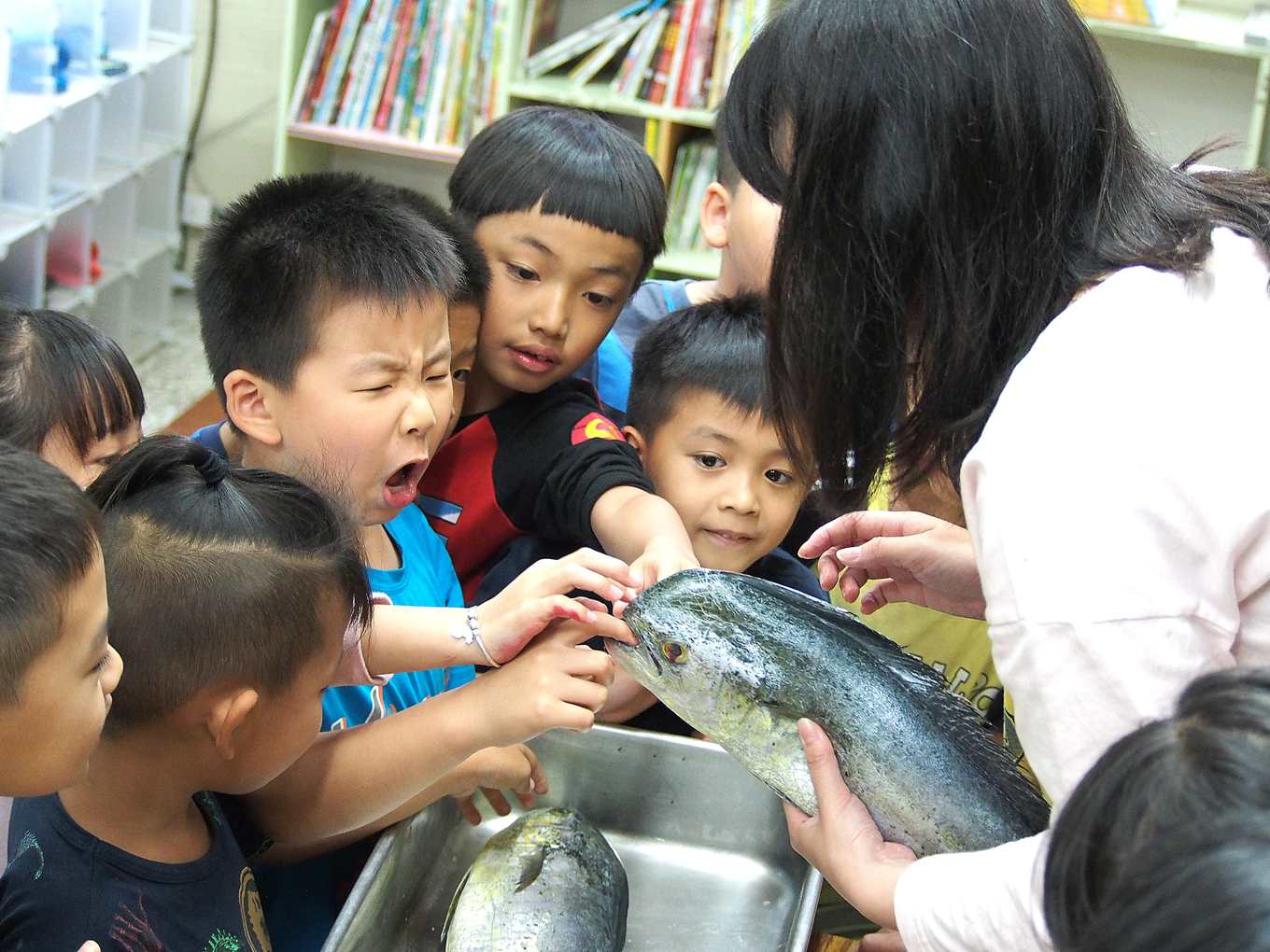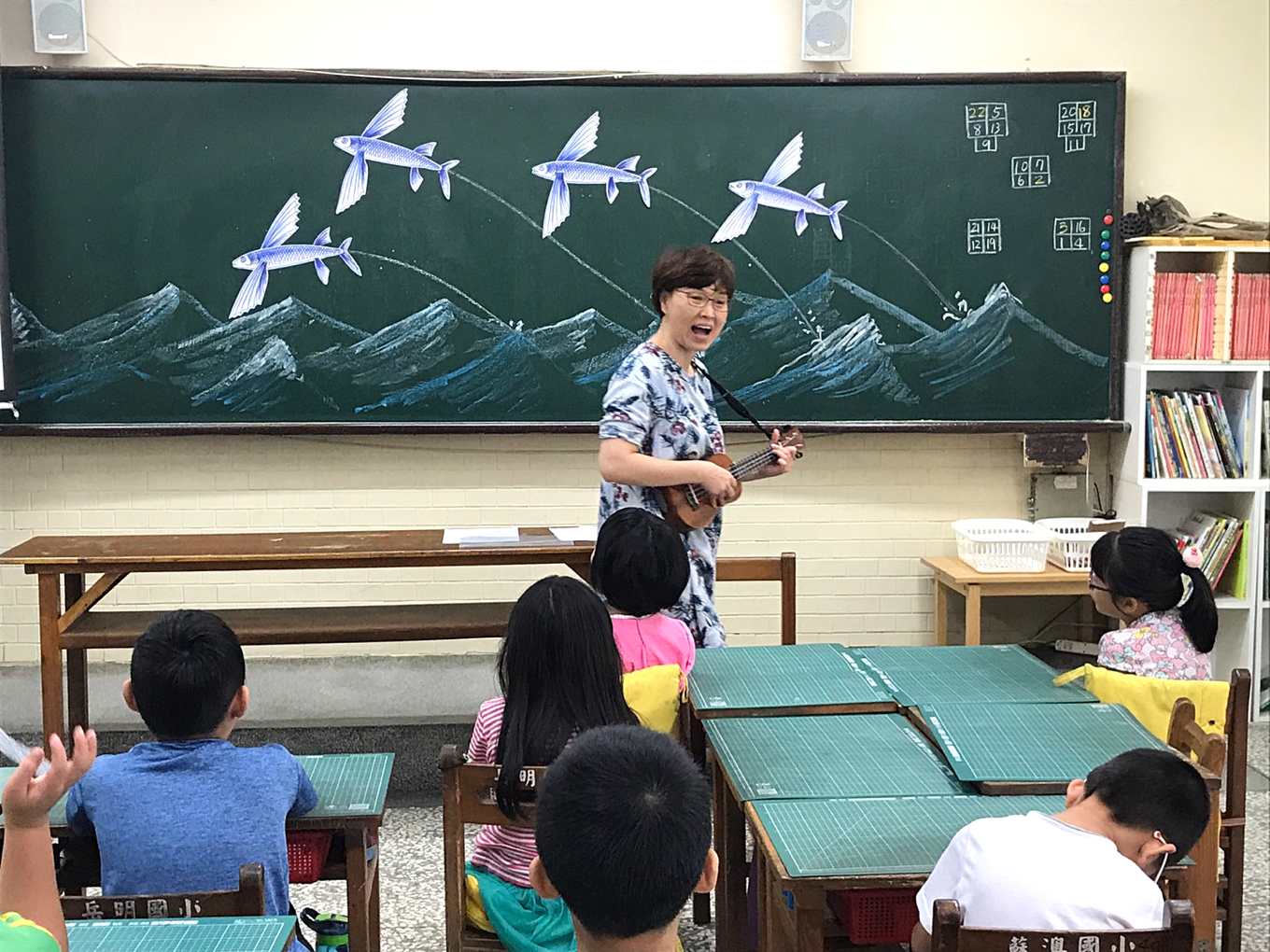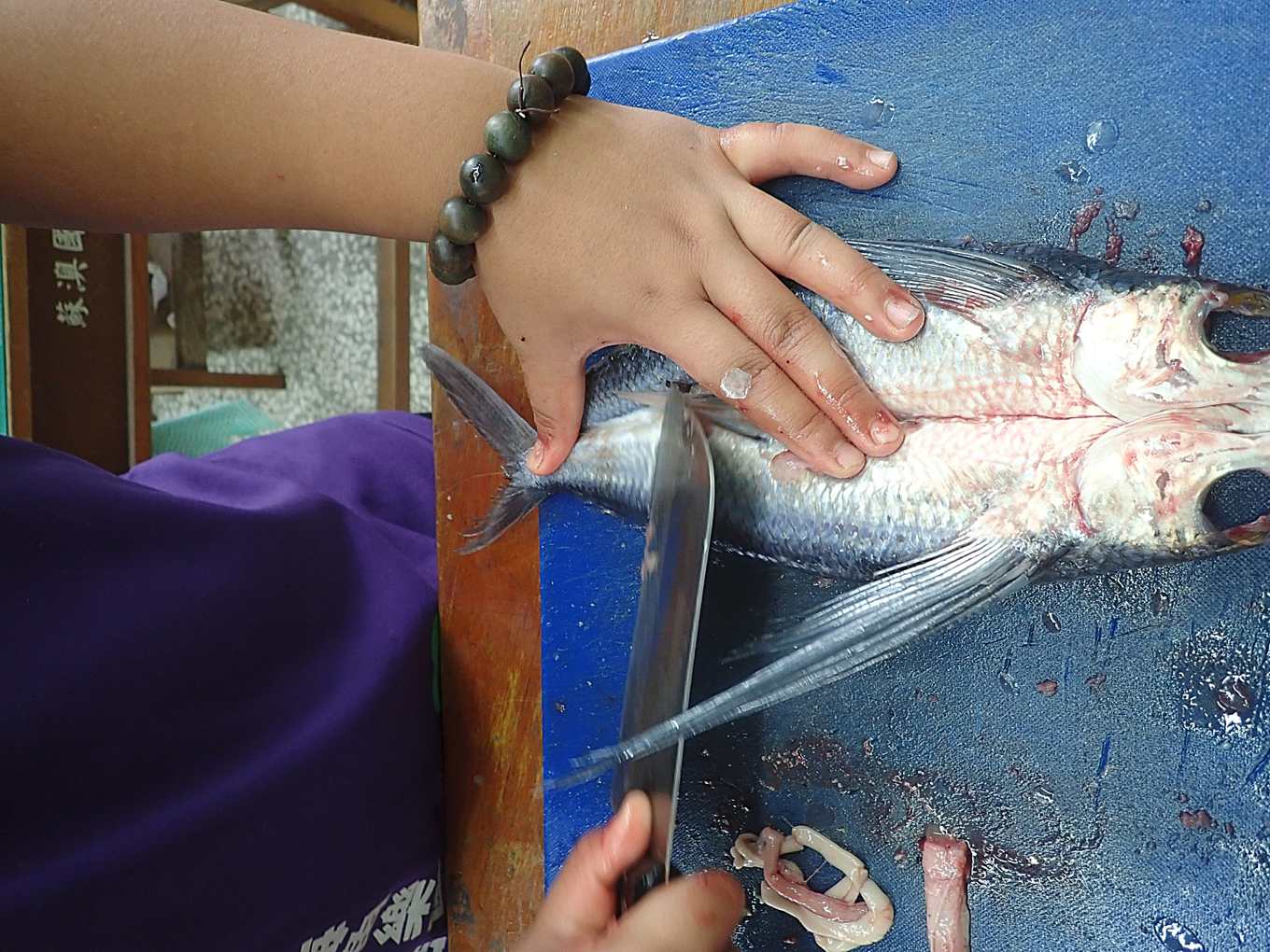Xu Chengyi / fish-eating education stuck by fishbones, Yue Ming Primary School made a brave breakthrough, extending marine education from the dining table.
1 sharing
In the past, marine education came from family and life, but now most parents do not have the ability to teach marine knowledge, and now the mode of production of fishing is more complex than in the past, and it is more distant from urban life. Many consumers find it difficult to eat fish. The dining table has become the strangest distance between people and the sea.
Since last year, we have cooperated with Yue Ming Primary School to explore a new channel of fish-eating education like a big voyage. after seven months of promotion, the journey ended with a pleasant surprise, and we also got a lot of harvest and response.

Provide / Xu Chengyi
At first, the biggest problem was to teach students how to find out the thorns in the fish and avoid being hit by the fish bones. It also teaches children the basic knowledge of the structure and appearance of fish. After six times of super-intensive study, ordinary fishbone shrimps and crabs can no longer defeat this group of children in grades 1 to 6; even children in grade 4 are invited to the Taiwan Museum to hold a sustainable New year's Eve dinner to teach adults and children how to pick the spines of mackerel and eat mackerel safely.
With initial confidence, Yue Ming Primary School launched the second stage of fish-eating education to continue the study of nine new fish species at the rate of one fish species in two weeks. In addition, not only the tutors of each class, but also the teachers of the whole school have devoted themselves to fish-eating education, and the results are even more amazing!

Provide / Xu Chengyi
Yue Ming's fish-eating education extends all-round learning from the dining table.
Recognize the appearance of living things-body type, body color, size, sex, name, species, physical observation, touch, …
Understand the physiology of living things-growth, reproduction, swimming, eating habits.
Ecology-habitat, food chain, migration...
Resources-quantity changes, resource status …
Mode of production-farming mode, fishing method, producing area apprenticeship, on-site internship.
Management method-Fisheries Management
Sales method-Marketing trainee
Cooking methods-slicing, cooking... Implementation
How to eat-Weekly experience
Music-singing of fish songs at home and abroad
Meilao-watercolors, ink, clay,
Literature-Mandarin, Taiwanese, English, phonetic
Games-all kinds of indoor and outdoor games replace exams
These educational methods are all prepared by school teachers, which are getting better and better each time. When flying fish has a song of flying fish, every fish has to find a song, if you can't find it, make up a song! When flying fish appeared in the classroom for the first time, everyone looked forward to the next fish in every class!

Provide / Xu Chengyi

In addition to singing, also learn how to kill fish (provided / Xu Chengyi)
How to face the fear of children being stabbed by fishbones?
In the process of eating fish more than 20 times, you may want to know: have any children been stabbed by fishbones? As it was expected in advance that some children might be stabbed, the school also prepared a response plan, which came in handy twice.
Once, a little girl in the first grade was stabbed by a fish at home the day before, so she was afraid when she ate the whole bamboo fish. As a result, she was really bitten by the fishbone that day, so the school followed the way agreed with the parents in advance. The teacher sent the students to the doctor to remove the fishbone and informed the parents. After the removal of the fishbone, the little girl is still afraid of the fishbone; it is really worrying that she will leave a long shadow on the fish in the future!
Later, when eating the whole black tail, the teacher specially accompanied the little girl to face the obstacle of picking fish bones and encouraged her to eat from the tail with fewer spines, because it was a very delicious fish. As a result, under the encouragement of the teacher, the little girl not only ate the tail, but also ate up the whole fish, because she thought the fish was so delicious!
Too delicious fish will also bring trouble, a middle-grade girl thought flying fish was delicious, as a result, she ate all the flying fish of the two students who did not come to the class. As a result, he became the second student to report to the hospital because he swallowed the fishbone too quickly. Eating fish is like riding a bicycle. If you learn to fall easily, the risk will be much less if you have adults to accompany you. But you still have to practice often. You will never forget it for the rest of your life, but those who can ride again will also fall if you are not careful.
Children in Shuangchun have all been bitten by fishbones, and they still love milkfish best.
In addition, I would like to share my experience in another primary school. Shuangchun Primary School in Tainan is a rural primary school with only 20 students. During the summer vacation, we also went to help our classmates take an ocean lesson. I asked curiously whether the children in this culture area, which specializes in raising milkfish, Taiwan snapper and clams, would eat whole milkfish by themselves.
The whole school raised their hands and said: yes. And ask everyone who has eaten milkfish and been bitten by a fishbone? The whole school raised their hands to show that they had been stabbed! Finally, what kind of fish do you think is the best? The answer is all: milkfish! From this case, I also firmly believe in how important it is to teach children to eat Taiwanese food!
"as long as the teacher is not afraid, the fishbone will not stop eating fish education."
In the 15 courses of Yue Ming Primary School, the principles of education can be summed up:
(1) from near to far-choose the common species on the ground, so that children can not leave the campus without fish.
(2) picking fish bones from simple to difficult requires gradual learning, starting with simple shelling shrimp.
(3) correct knowledge as the basis-all course contents should be based on evidence, rigorous verification, saying that they do not know what they do not know, and must not cover the whole course and transmit wrong knowledge.
(4) all-round learning-seeing, listening, touching, tasting, thinking, writing, painting, moving.
(5) learn from childhood-appropriate and different teaching methods are given to different ages, and there are different learning methods from first grade to sixth grade.
(6) good fish and slow food-give students enough time to pick and taste, and cultivate the fun of tasting food.
(7) make a habit of not only having seafood in class and eating seafood every week, but also giving the best seafood the most careful cooking and getting into the habit of eating seafood.
The curriculum so painstakingly built is not only for Yue Ming's happy students, but also to share it with teachers and students all over Taiwan! Yue Ming's teachers are not idle this summer. We are preparing 15 fish-eating education experiences for lower, middle and senior grades, which we want to share with schools all over the country. There are also many NGO friends to help promote. Almost all parents approve of fish-eating education in schools, and many schools are also very curious and interested, but most principals are still stuck by a small fishbone!
The unknown is the greatest fear. When students do not know where the fishbone is, they will have fear that they will not have the opportunity to eat fish. Because the school does not know how to teach, there is no way to carry out fish-eating education. But in Yue Ming's experience, we have proved that this can be taught and learned! To paraphrase the words of Principal Xiao Huang of Yue Mingguo, he shared with all the schools: "as long as the teacher is not afraid, the fish bone will not stop eating fish education."

Yue Ming's children are not afraid of fishbones (provided by Xu Chengyi)
Correct fish-eating education to train future marine citizens
The "fish-eating education on campus" in the past seven months has given us a lot of valuable enlightenment. Why is it so important to carry out fish-eating education on campus? We have summed up the seven major importance of fish-eating education and would like to share with you:
(1) raise awareness and concern for the environment: fish-eating education is part of food and education, but wild fishing seafood is the only crop in today's commercial food production that is not planned by human beings. Therefore, when eating seafood, we need to add more understanding of the environment and ecology, and then arouse concern.
(2) cultivate the habit of consuming local fish products: like all food, the cultivation of taste starts from childhood, and the diversified taste of seafood takes more time to develop the memory of the body.
(3) support local agriculture and maintain food security: land production and land marketing is not a new slogan, but the main supply and marketing mode of agriculture. Real estate should be supported by land sales, and land sales should be supplied by real estate, which is the most effective strategy to maintain food security.
(4) safeguard the health of consumers: it is well known that there are many nutrients in seafood that are not available in land-based food. if consumers do not understand fish, they will not be able to eat seafood correctly, not only can they not get the precious nutrients in the sea, but also may cause health hazards by eating bad seafood.
(5) protect the rights and interests of consumers: when consumers are faced with a wide variety of seafood, if they lack the right knowledge, they are likely to make the wrong choice and spend money!
(VI) promoting effective fisheries management: the purpose of fishery production is to supply consumers, including food supply and economic value creation, so consumer demand is an important guide to guide production. Consumers provide an important pull when Taiwan is gradually building an effective fishery management system.
(7) assist in the sustainable use of the ocean: responsible producers provide healthy supply, consumers who understand fish provide healthy demand, and both producers and consumers need good marine literacy. Fish education is the most solid way to provide consumers with good marine literacy!
- Prev

Peace Island Park Angel to the Sea Trail Show Transnational Cooperation Combined with Fashion and Environmental Protection
Keelung City-yesterday (17) with the Ministry of Communications Tourism Bureau North Coast and Guanyinshan National Scenic Area Management Office jointly held "2019 Keelung fashion environmental protection fashion show" activities, and French famous clothing brand ANNEFONTAINE(Anfangda) cooperation, 6 models...
- Next

Taitung County-xC! ty`Super Top supermarket Media Association debut
"Taitung's products have potential and are worth selling in the high-end market," Taitung County-partnered with C! ty`Super, a top supermarket with an annual turnover of more than 10 billion yuan for the first time, and jointly held a "2019 top supermarket access selection physical examination" on the 18th.
Related
- A course of planting techniques and methods on how to grow carrots
- How to plant the latest tulips?
- Is it better to pick tea in the morning or in the afternoon? When is the best time for tea to be picked? what is the third or fifth tea?
- Launch Yuanxiao Happy combination Haocha + Tea Yuan healthy Taste
- Penghu Tourism "Fireworks 20 Parade with You"
- 2022 West Lake Happiness holds "Digital Revitalization Voucher" and draws iphone13 and laptop.
- Banqiao Fuzhou social houses are designed to change start-up combined with police elimination to create a safe and livable environment
- The convenient measure of "mechanical weeding" in Xinbei has been abused and the Agriculture Bureau has imposed heavy penalties on the illegal land consolidation.
- Changgeng University Joins Hands with Four Memory Factories to Rescue Memory Talent Shortage
- The list of Taiwan's top 100 MVP managers is listed by the Director-General of the Farmers' Association of Sanxia District.

